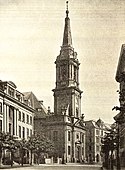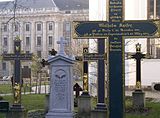
The Protestant Church in Germany, formerly known in English as the Evangelical Church in Germany, is a federation of twenty Lutheran, Reformed, and United Protestant regional Churches in Germany, collectively encompassing the vast majority of the country's Protestants. In 2022, the EKD had a membership of 19,153,000 members, or 22.7% of the German population. It constitutes one of the largest Protestant bodies in the world. Church offices managing the federation are located in Herrenhausen, Hanover, Lower Saxony. Many of its members consider themselves Lutherans.

The Berlin Cathedral, also known as the Evangelical Supreme Parish and Collegiate Church, is a monumental German Protestant church and dynastic tomb on the Museum Island in central Berlin. Having its origins as a castle chapel for the Berlin Palace, several structures have served to house the church since the 15th century. The present collegiate church was built from 1894 to 1905 by order of Emperor William II according to plans by Julius Raschdorff in Renaissance and Baroque Revival styles. The listed building is the largest Protestant church in Germany and one of the most important dynastic tombs in Europe. In addition to church services, the cathedral is used for state ceremonies, concerts and other events.
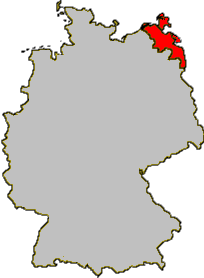
The Pomeranian Evangelical Church was a Protestant regional church in the German state of Mecklenburg-Vorpommern, serving the citizens living in Hither Pomerania. The Pomeranian Evangelical Church was based on the teachings brought forward by Martin Luther and other Reformators during the Reformation. It combined Lutheran and Reformed traditions. The seat of the church was Greifswald, the bishop's preaching venue was the former Collegiate Church of St. Nicholas in Greifswald.

The Prussian Union of Churches was a major Protestant church body which emerged in 1817 from a series of decrees by Frederick William III of Prussia that united both Lutheran and Reformed denominations in Prussia. Although not the first of its kind, the Prussian Union was the first to occur in a major German state.

The French (Reformed) Church of Friedrichstadt is in Berlin at the Gendarmenmarkt, across the Konzerthaus and the German Cathedral. The earliest parts of the church date back to 1701, although it was subsequently expanded. After being heavily damaged during World War II, the church was rebuilt and continues to offer church services and concerts.

The Protestant Church of the Redeemer is located to the south of the village of Sacrow, which since 1939 has been incorporated to Potsdam, the capital of the German Bundesland of Brandenburg. It is famous for its Italian Romanesque Revival architecture with a separate campanile and for its scenic location. It was built in 1844. The design was based on drawings by King Frederick William IV of Prussia, called the Romantic on the Throne. The building was realized by Ludwig Persius, the king's favorite architect. In 1992, the church along with the park and Sacrow Manor was added by UNESCO to the World Heritage Site "Palaces and Parks of Potsdam and Berlin" for its architecture and cohesion with the surrounding park.

Königs Wusterhausen is a town in the Dahme-Spreewald district of the state of Brandenburg in Germany a few kilometers outside Berlin.

The St. Nikolai-Kirche, is the oldest church in Berlin, the capital of Germany. The church is located in the eastern part of central Berlin, the borough of Mitte. The area around the church, bounded by Spandauer Straße, Rathausstraße, the River Spree and Mühlendamm, is known as the Nikolaiviertel 'Nicholas quarter', and is an area of restored medieval buildings. The church was built between 1220 and 1230, and is thus, along with the Church of Our Lady at Alexanderplatz not far away, the oldest church in Berlin.

Lindow in der Mark, short: Lindow (Mark), is a town in the Ostprignitz-Ruppin district, in Brandenburg, Germany. It is located 14 km northeast of Neuruppin, and 29 km northwest of Oranienburg. The town is situated on an isthmus between the lakes Gudelacksee and Wutzsee.
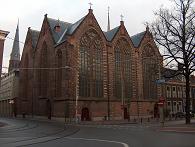
The Kloosterkerk is a church on the Lange Voorhout in The Hague, Netherlands. The church and its accompanying monastery were first built in 1397. The church is known today as the church where Beatrix of the Netherlands occasionally attended services.
A shared church, simultaneum mixtum, a term first coined in 16th-century Germany, is a church in which public worship is conducted by adherents of two or more religious groups. Such churches became common in the German-speaking lands of Europe in the wake of the Protestant Reformation. The different Christian denominations, share the same church building, although they worship at different times and with different clergy. It is thus a form of religious toleration.

Jerusalem Church is one of the churches of the Evangelical Congregation in the Friedrichstadt, a member of the Protestant umbrella organisation Evangelical Church of Berlin-Brandenburg-Silesian Upper Lusatia. The present church building is located in Berlin, borough Friedrichshain-Kreuzberg, in the quarter of Friedrichstadt. Jerusalem Church is fourth in rank of the oldest oratories in the town proper.
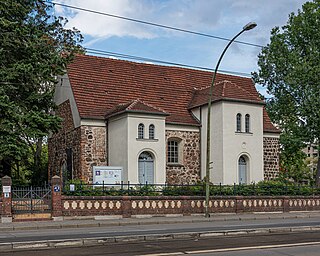
Tabor Church (Hohenschönhausen) is the church of the Evangelical Berlin-Hohenschönhausen Congregation, a member of today's Protestant umbrella organisation Evangelical Church of Berlin-Brandenburg-Silesian Upper Lusatia. The church building is located in the Berlin borough of Lichtenberg, in the locality of Alt-Hohenschönhausen. The church was named in memory of the Transfiguration of Jesus, which allegedly took place on Mount Tabor in today's Israel.
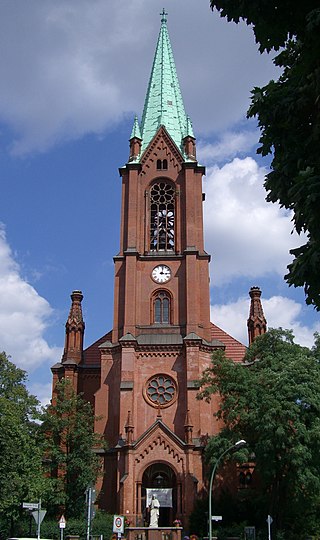
Gethsemane Church is one of four church buildings of the Lutheran Northern Prenzlauer Berg Evangelical Congregation, within the Evangelical Church of Berlin-Brandenburg-Silesian Upper Lusatia, an umbrella organisation which includes Lutheran, Reformed, and United Protestant Calvinist congregations.

Saint John's Lutheran Church is an active church building located at 121 South Locust Street in the city of Adrian in Lenawee County, Michigan. It was designated as a Michigan State Historic State on February 23, 1981 and shortly after listed on the National Register of Historic Places on December 27, 1984. The Lutheran congregation moved to a new home in 2007, and the church building now houses the Reformed Baptist Church of Lenawee.
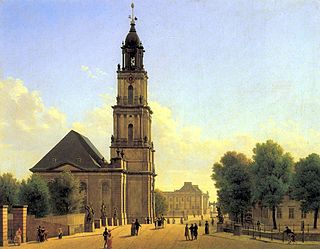
The Garrison Church was a Protestant church in the historic centre of Potsdam. Built by order of King Frederick William I of Prussia according to plans by Philipp Gerlach from 1730 to 1735, it was considered as a major work of Prussian Baroque architecture. With a height of almost 90 metres, it was Potsdam's tallest building and shaped its cityscape. In addition, the Garrison Church was part of the city's famous "Three Churches View" together with the St. Nicholas Church and the Holy Spirit Church. After it was damaged during the British bombing in World War II, the East German authorities demolished the church in 1968. After the German reunification, the Garrison Church is currently being rebuilt as a centre for remembrance and reconciliation.
More than 60 percent of Berlin residents have no registered religious affiliation. As of 2010, at least 30 percent of the population identified with some form of Christianity, approximately 8.1 percent were Muslim, 1 percent were Jewish, and 1 percent belonged to other religions. As of 2018, the number of registered church members has shrunk to 14.9 percent for EKD Protestants and 8.5 percent for Catholics.

In Protestant usage, a consistory designates certain ruling bodies in various churches. The meaning and the scope of functions varies strongly, also along the separating lines of the Protestant denominations and church bodies.

Grace Lutheran Church in Uniontown, Missouri is a member congregation of the Lutheran Church–Missouri Synod (LCMS).

